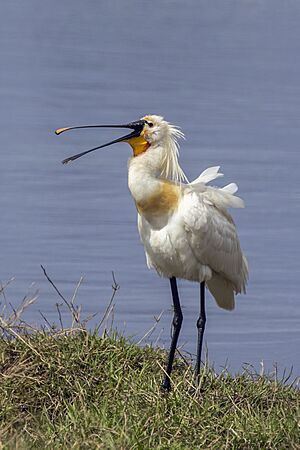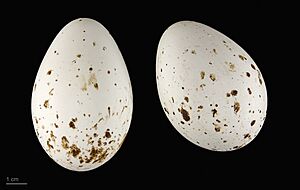Eurasian spoonbill facts for kids
The Eurasian spoonbill (Platalea leucorodia), also known as the common spoonbill, is a special wading bird. It belongs to the same family as ibises and other spoonbills, called Threskiornithidae. This bird gets its name from its unique, flat, spoon-shaped bill. The word Platalea comes from Latin and means "broad," referring to its wide bill. Leucorodia comes from Ancient Greek words meaning "white" and "heron," describing its white color.
Quick facts for kids Eurasian spoonbill |
|
|---|---|
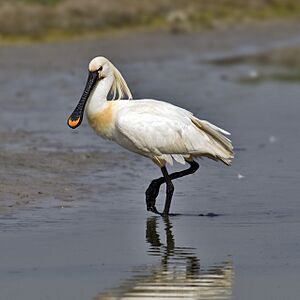 |
|
| Adult in breeding plumage | |
| Conservation status | |
| Scientific classification | |
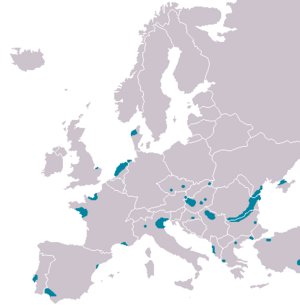 |
|
| Breeding range in Europe in blue (also in Asia and Africa, not shown) |
Contents
What Makes the Eurasian Spoonbill Special?
The Eurasian spoonbill is easy to spot in most places where it lives. Adult birds are completely white. They have dark legs and a black bill with a yellow tip. During breeding season, they also have a yellow patch on their chest and a crest of feathers on their head.
How to Identify a Spoonbill
- Adults: All white with dark legs. Their bill is black with a yellow tip.
- Breeding Adults: Have a yellow chest patch and a crest of feathers.
- Young Birds: Have a pale bill and black tips on their main flight feathers.
- Flight: Unlike herons, spoonbills fly with their necks stretched out.
How Do Spoonbills Sound?
Eurasian spoonbills are usually quiet birds. Even when they are in their breeding colonies, they mostly make sounds by snapping their bills. Sometimes, you might hear a deep grunt or a trumpeting noise.
Where Do Eurasian Spoonbills Live?

These birds are found across a wide area. They live in Europe, Asia, and Africa.
Their Homes Around the World
- Europe: They breed from the United Kingdom and Portugal in the west. You can find them locally through Europe, north to Denmark, and east to the Balkans and the Black Sea.
- Asia: They breed in a wide band across the central part of Asia. This stretches from the Black Sea to the Korean Peninsula. They also live in Kuwait, southern Iraq, Iran, southern Pakistan, India, and Sri Lanka.
- Africa: They breed in certain coastal areas of Mauritania. They are also found more widely along the Red Sea and Gulf of Aden coasts.
Do They Migrate?
Birds that breed in warmer parts of Asia, Africa, and Spain usually stay in those areas. They might only move short distances. However, spoonbills from more northern areas often migrate south. They spend winter in the northern half of Africa or warmer parts of Asia. Some northern birds also stay in places like the United Kingdom, France, and the Mediterranean during winter.
What Kind of Places Do They Like?
Eurasian spoonbills prefer large, shallow wetlands. These places often have muddy or sandy bottoms. They can live in many types of wet areas, such as:
- Marshes
- Rivers
- Lakes
- Floodplains
- Bogs
- Mangrove swamps
They like both fresh, salty, or slightly salty water. They especially like areas with quiet islands for nesting. They also like dense plants along the water's edge, like reeds, bushes, and scattered trees such as willow, oak, or poplar. In winter, they might visit sheltered ocean areas like deltas and coastal lagoons.
Eurasian Spoonbill Life and Habits
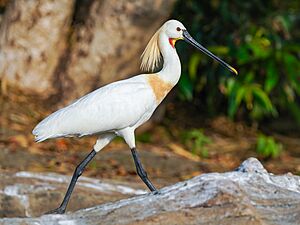
Some spoonbill groups migrate long distances, while others only move a little. Some groups stay in the same area all year.
Reproduction and Breeding
In cooler northern areas, spoonbills breed in spring, usually starting in April. In tropical areas, they time their breeding with the rainy season. They often breed in colonies, which are large groups of birds. Sometimes, they form their own colonies. Other times, they join colonies with different waterbirds like herons and cormorants.
- Nests: Their nests are platforms made of sticks and plants. They build them on the ground on islands in lakes or rivers. They also build them in thick reeds, bushes, mangroves, or trees up to 5 meters (about 16 feet) high.
- Colony Life: Nests in a colony are usually close together, about 1 to 2 meters (3 to 6 feet) apart. Breeding colonies are often located within 10 to 15 kilometers (6 to 9 miles) of their feeding areas.
How Do Spoonbills Find Food?
Outside the breeding season, Eurasian spoonbills usually look for food alone or in small groups of up to 100 birds. They are most active in the morning and evening. If they live near the coast, their feeding times depend on the tides. They often rest together in large groups, sometimes as far as 15 kilometers (9 miles) from where they eat.
What Do Spoonbills Eat?
Their diet mainly consists of small aquatic animals. They eat:
- Water insects
- Snails and other mollusks
- Newts
- Crabs and other crustaceans
- Worms
- Leeches
- Frogs and tadpoles
- Small fish (up to 10-15 cm or 4-6 inches long)
They use their unique spoon-shaped beaks to sweep sideways through the water. This helps them filter out tiny fish and shrimp. They might also accidentally eat algae or small pieces of water plants.
Protecting the Eurasian Spoonbill
Overall, the Eurasian spoonbill is not currently considered an endangered species. In 2015, there were an estimated 63,000 to 65,000 adult birds worldwide.
Population Changes in Europe
In Europe, the number of spoonbills went down between 1960 and 1990. But since then, their population has been growing! In 2020, there were about 29,000 adult birds in Europe.
- The Netherlands: In 1968, there were fewer than 150 breeding pairs. Thanks to better habitat protection and bans on harmful chemicals like DDT, the population grew quickly. By 2015, it reached almost 3,000 pairs.
- Denmark: The first known breeding in Denmark was in 1900. The population was small and irregular for a long time. But since 1996, the number of spoonbills has increased rapidly. By 2021, there were almost 600 pairs. Warmer temperatures might be helping them spread north.
- United Kingdom: Spoonbills disappeared from the UK around 1668. They started trying to breed again in the mid-1990s and successfully bred in 1998. By 2018, a small colony in Norfolk had grown to 28 breeding pairs.
Challenges They Face
Even though their numbers are growing, spoonbills still face challenges:
- Habitat Loss: Their wetland homes are sometimes drained or polluted.
- Reed Swamps: They are especially affected when reed swamps disappear.
- Disturbance: People disturbing them, especially during fishing, has caused problems in the past.
- Predators: Predators like red foxes can threaten their nests. This is why colonies are often found on islands where ground predators can't reach them. However, some birds on the mainland can still breed successfully by nesting in trees and bushes.
To help protect these birds, a group called the Eurasian Spoonbill International Expert Group was formed in 1991. They created an action plan for the bird in 2008 and joined an agreement for migratory waterbirds in 2013.
Images for kids
-
Immature Eurasian spoonbill, Bundala National Park



